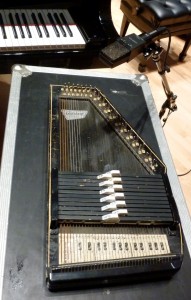Westering (2010)
for hexaphonic electric guitar and chamber orchestra (1.1.1.1 / 1.1.1. / 2 perc. / harp / piano (doubling just intonation autoharp in G) / mandolin / strings [6.5.4.3.2]) [15:00]
“…and on West-ward, wherever ’tis not yet mapp’d, nor written down, nor ever, by the majority of Mankind, seen… ever behind the sunset, safe till the next Territory to the West be seen and recorded, measur’d and tied in, back into the Net-Work of Points already known, that slowly triangulates its Way into the Continent, changing all from subjunctive to decarative, reducing Possibilities to Simplicities that serve the ends of Governments,— winning away from the realms of the Sacred, its Borderlands one by one…” —Thomas Pynchon, Mason & Dixon
 Westering evokes the idea of a westward movement. The piece is largely inspired by music associated with the west: country and western guitar timbres, West African balafon music—but above all music from California: the just intonation ratios and plucked-string instruments of Harry Partch (to whom the adapted autoharp played by the pianist pays homage), Los Angeles folk/rock (Joni Mitchell’s chains of consonant harmonies, Jeff Lynne’s superimposed layers of strummed guitars), as well as psychedelic rock from San Francisco and its rig of classic guitar effects.
Westering evokes the idea of a westward movement. The piece is largely inspired by music associated with the west: country and western guitar timbres, West African balafon music—but above all music from California: the just intonation ratios and plucked-string instruments of Harry Partch (to whom the adapted autoharp played by the pianist pays homage), Los Angeles folk/rock (Joni Mitchell’s chains of consonant harmonies, Jeff Lynne’s superimposed layers of strummed guitars), as well as psychedelic rock from San Francisco and its rig of classic guitar effects.
The soloist is a hexaphonic guitar: an electric guitar fitted with a hexaphonic pickup that sends out a separate signal for each string—a recent innovation that opens up a wide range of new possibilities. The pitch of each sting can be transposed independently by the electronics, or effects can be applied with a different rate to each string, creating a polyrhythmic tremolo for instance, a six-voice wah- wah effect, or a dynamic delay that transforms a strummed chord into an arpeggio or a fingerpicking pattern. Spatializing each string separately as well—to a four-speaker setup that surrounds the audience—the live electronics control the pitch, timbre, and movement of several independent layers in real time. Towards the end of the piece, IRCAM’s computer-aided orchestration software Orchidée was used to orchestrate the timbre and pitch content of heavily distorted electric guitar chords, transforming them into a sort of halo or haze in the orchestra behind the soloist.
The image of a westward wandering is also embodied in the loose form of the piece, a chain of interlocking events that unfurl like a series of discoveries in an unfamiliar landscape, the western myth of perpetual possibility…